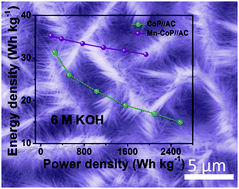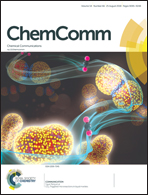Hierarchical three-dimensional manganese doped cobalt phosphide nanowire decorated nanosheet cluster arrays for high-performance electrochemical pseudocapacitor electrodes†
Abstract
Ternary metal phosphides with a self-assembled hierarchical nanostructure are promising electrode materials for energy storage and conversion, due to the unique architecture and synergistic effects in bimetallic nanostructures. In this communication, we demonstrate hierarchical Mn-doped cobalt phosphide nanowire decorated nanosheet cluster arrays with robust adhesion on Ni foam (Mn–CoP/NF) as a binder-free electrode for supercapacitors. Such a 3D electrode exhibits boosted areal specific capacitance over that for a single metal counterpart, with the accomplishment of 8.66 F cm−2 capacitance at 1 mA cm−2. Utilizing the Mn–CoP/NF electrode as an anode and an activated carbon (AC) electrode as a cathode, an asymmetric supercapacitor (ASC) of Mn–CoP//AC attains a high area capacitance of 2.05 F cm−2 at 5 mA cm−2 and a high capacitance retention of 88.9% after 4000 cycles. In addition, the assembled ASC shows superior electrochemical performances with a high energy density of 35.21 W h kg−1 at a power density of 193 W kg−1 and of 30.87 W h kg−1 even at 1939 W kg−1.



 Please wait while we load your content...
Please wait while we load your content...